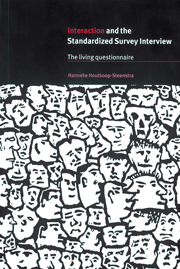Book contents
- Frontmatter
- Contents
- Preface
- Acknowledgments
- Glossary of transcript symbols
- 1 The standardized survey interview
- 2 Interviewer–respondent interaction
- 3 Participant roles
- 4 Recipient design
- 5 Questioning-turn structure and turn taking
- 6 Generating recordable answers to field-coded questions
- 7 Establishing rapport
- 8 Quality of Life assessment interviews
- 9 Implications for survey methodology
- Notes
- References
- Subject index
Preface
Published online by Cambridge University Press: 22 September 2009
- Frontmatter
- Contents
- Preface
- Acknowledgments
- Glossary of transcript symbols
- 1 The standardized survey interview
- 2 Interviewer–respondent interaction
- 3 Participant roles
- 4 Recipient design
- 5 Questioning-turn structure and turn taking
- 6 Generating recordable answers to field-coded questions
- 7 Establishing rapport
- 8 Quality of Life assessment interviews
- 9 Implications for survey methodology
- Notes
- References
- Subject index
Summary
I have researched conversation since I graduated from the Department of General Linguistics at the University of Amsterdam. For the first seven years I studied everyday telephone conversations, and I then became interested in what I referred to as “interviewing techniques” in doctor–patient interaction. What did the textbooks say about how medical doctors should interact with their patients, and how did these interviewing techniques work out in real interactions? The advice these books provided was mainly based on psychological and socio-psychological theories of human interaction, and the real interactions often were not as successful as the textbooks predicted.
Being interested in interaction, and especially in the relationship between “how it should be done” and “how it is actually done,” I chose the standardized survey interview as a uniquely interesting research object. A considerable amount of what we know about the social world comes from survey research that finds its way into books, articles, and the mass media. This survey research occasionally provides some general information about the questionnaire, the sample interviewed, and the statistical analysis, but it does not explain what actually happens in the interviews. In fact, the reader and/or user of survey research results is made to believe that interviewers read the questions exactly as they are scripted and respondents behave exactly as they are supposed to behave.
In order to learn what is going on in this part of the survey research procedure, we need to examine questionnaires and analyze recorded interviews.
Information
- Type
- Chapter
- Information
- Interaction and the Standardized Survey InterviewThe Living Questionnaire, pp. vii - xPublisher: Cambridge University PressPrint publication year: 2000
